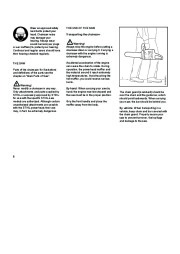From inside (document excerpt):
STIHL 017 018 Instruction Manual Owner’s Manual Assembling Safety Precautions Operating Instructions Maintenance Warning! Read and follow all safety precautions in Owner’s Manual improper use can cause serious or fatal injury. To reduce risk of kickback injury use STIHL reduced kickback bar and STIHL PMN (3/8 Picco) or PM 1 (3/8 Picco) chain depending on sprocket pitch or other available low kickback components. Andreas Stihl 1993 Important Safety Precautions for Chain Saw Users A. Kickback Safety Precautions take several steps to keep your cutting jobs free from accident or injury.
1. With a basic understanding of kickback, you can reduce or eliminate the element of surprise. Sudden surprise contributes to accidents. Keep a good firm grip on the saw with both hands, the right hand on the rear handle, and the left hand on the front handle, when the engine is running. Use a firm grip with thumbs and fingers encircling the chainsaw handles. A firm grip will help you reduce kickback and maintain control of the saw. Don’t let go. Make sure the area in which you are cutting is free from obstructions. Do not let the nose of the guide bar contact a log, branch, or any other obstruction while you are operating the saw. Cut at high engine speeds. Do not overreach or cut above shoulder height. continued on the back inside cover 6. Follow manufacturer’s sharpening and maintenance instructions for the saw chain. Only use replacement bars and chains specified by the manufacturer or the equivalent. Reduced kickback bars and low kickback chains are designed to reduce the risk of kickback injury. Ask your STIHL dealer about these devices. !Warning! Kickback may occur when the nose or tip of the guide bar touches an object, or when the wood closes in and pinches the saw chain in the cut. Tip contact in some cases may cause a lightning fast reverse reaction, kicking the guide bar up and back towards the operator. Pinching the saw chain along the top of the guide bar may push the guide bar rapidly back towards the operator. Either of these reactions may cause you to lose control of the saw which could result in serious personal injury. Section 5.12 of ANSI B 175.1-1991 sets certain performance and design criteria related to chainsaw kickback. STIHL has developed a color code system using green and yellow to help you select a powerhead, bar and chain combination that complies with the kickback requirements of the ANSI Standard. See the sections entitled “Safety Precautions ” and “Specifications ” of this manual. Do not rely exclusively upon the safety devices built into your saw. As a chainsaw user, you should 7. 8. 2. B. Other Safety Precautions 1. Do not operate a chainsaw with one hand! Serious injury to the operator, helpers, bystanders, or any combination of these persons may result from onehanded operation. A chainsaw is intended to be used with two hands. Do not operate a chainsaw when you are fatigued. Use safety footwear; snug-fitting clothing; protective gloves; and eye, hearing, and head protection devices. Contents Main Parts of the Saw Definitions Safety Precautions – The Operator – The Saw – The Use of the Saw – Maintenance, Repair and Storing Mounting the Bar and Chain: – Models with Quick Chain Tensioner* Tensioning the Saw Chain Checking Chain Tension Fuel Mix Fueling Chain Lubricant Filling Chain Oil Tank Checking Chain Lubrication Chain Brake Information Before You Start Starting During Break-in Period During Operation After Finishing Work Cleaning Air Filter Taking Care of Guide Bar Motormanagement Adjusting Carburetor Spark Arresting Screen in Muffler Checking Spark Plug Starter Rope Checking and Replacing Chain Sprocket Storing the Machine Maintaining and Sharpening Saw Chain Maintenance Chart Specifications Ordering Spare Parts Stihl Incorporated Limited Warranty Federal and California Emission Control Systems Utility Engines 37 37 38 38 39 39 40 41 41 42 42 43 46 47 48 49 This manual contains operating and safety instructions for all STIHL 017, 018 series chainsaws. Pay special attention to the safety precautions outlined on the inside cover and on pages 4 to 24. Allow only persons who understand this Manual to operate your chainsaw. To receive maximum performance and satisfaction from your STIHL chainsaw, it is important that you read and understand the maintenance and safety precautions before using your saw. Contact your STIHL dealer or the STIHL distributor for your area if you do not understand any of the instructions in this Manual. !Warning! Because a chainsaw is a high-speed wood-cutting tool, some special safety precautions must be observed as with any other power saw to reduce the risk of personal injury. Careless or improper use may cause serious or even fatal injury. STIHL’s philosophy is to continually improve all of its products. As a result, engineering changes and improvements are made from time-to-time. If the operating characteristics or the appearance of your saw differ from those described in this Manual, please contact your STIHL dealer for information and assistance. * Special equipment Printed on chlorine-free paper 2000 Andreas Stihl AG & Co., Waiblingen 0458 143 3021. M5. C0. PM. Printed in USA 017, 018 1 Main Parts of the Saw Twist lock Spark plug boot Decompression valve * Chain brake Chain sprocket Chain sprocket cover Chain catcher Chain tensioner Adjusting wheel of quick tensioner * Bumper spike Guide bar Oilomatic saw chain 143BA050 KN 13 Oil filler cap Muffler Front hand guard Front handle (handlebar) Starter grip Fuel filler cap Master Control lever Throttle trigger Throttle trigger interlock Rear handle Rear hand guard * Special accessory 2 017, 018 Definitions 1. 2. Carburetor Box Cover Twist Lock Lock for carburetor box cover. Spark Plug Boot Connects the spark plug with the ignition wire. Decompression Valve Releases compression pressure to make starting easier. Chain Brake A device to stop the rotation of the chain if activated in a kickback situation by the operator’s hand or by inertia. Chain Sprocket The toothed wheel that drives the saw chain. Chain Sprocket Cover Covers the clutch and the sprocket. Chain Catcher Helps to reduce the risk of operator contact by a chain when it breaks or comes off the bar. Chain Tensioner Permits precise adjustment of chain tension. Adjusting Wheel Permits precise adjustment of chain tension. 11. Guide Bar Supports and guides the saw chain. 12. Oilomatic Saw Chain A loop consisting of cutters, tie straps and drive links. 13. Oil Filler Cap For closing the oil tank. 14. Muffler Reduces engine exhaust noise and directs the exhaust gases. 15. Front Hand Guard Provides protection against projecting branches and helps prevent left hand from touching the chain if it slips off the handle bar. It also serves as the lever for chain brake activitation 16. Front Handle Handle bar for the left hand at front of saw. 17. Starter Grip The grip of the starter, for starting the engine. 18. Fuel Filler Cap For closing the fuel tank. 19. Master Control Lever Lever for choke control, starting throttle, run and stop switch position. 20. Throttle Trigger Controls the speed of the engine. 21. Throttle Trigger Interlock Must be depressed before the throttle trigger can be activated. 22. Rear Handle The support handle for the right hand, located at or toward the rear of the saw. 23. Rear Hand Guard Gives added protection to operator’s right hand. Guide Bar Nose The exposed end of the guide bar. (not illustrated, see chapter “Tensioning the Saw Chain “). Clutch Couples engine to chain sprocket when engine is accelerated beyond idle speed. (not illustrated). Anti-Vibration System The anti-vibration system includes a number of buffers designed to reduce the transmission of vibrations created by the engine and cutting attachment to the operator’s hands. (not illustrated)


 STIHL Owners Manual - 1 of 54
STIHL Owners Manual - 1 of 54 STIHL Owners Manual - 2 of 54
STIHL Owners Manual - 2 of 54 STIHL Owners Manual - 3 of 54
STIHL Owners Manual - 3 of 54 STIHL Owners Manual - 4 of 54
STIHL Owners Manual - 4 of 54 STIHL Owners Manual - 5 of 54
STIHL Owners Manual - 5 of 54 STIHL Owners Manual - 6 of 54
STIHL Owners Manual - 6 of 54 STIHL Owners Manual - 7 of 54
STIHL Owners Manual - 7 of 54 STIHL Owners Manual - 8 of 54
STIHL Owners Manual - 8 of 54 STIHL Owners Manual - 9 of 54
STIHL Owners Manual - 9 of 54 STIHL Owners Manual - 10 of 54
STIHL Owners Manual - 10 of 54